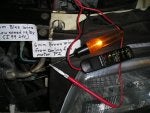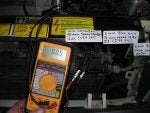"Troubleshooting 164 Cooling Fan System Part one"
Troubleshooting 164 Cooling Fan System
Troubleshooting 164 Cooling Fan System
First check cooling fan motor and motor power circuit to see if fan motor P2 will run without worrying about whether control circuits controlled by ignition switch B2, fuse F14, fan relays, low speed resistor, A/C trinary switch or radiator switch are working.
1. First off verify fan motor P2 will turn by hand. If motor seized remove, replace bearings or replace motor.
2. Verify 12v power (HOT AT ALL TIMES) at both sides of 40A fuse bar G254 on false firewall. Replace cracked or burned fuse bar with new Alfa one or a 45A Honda fuse bar. Do not hot wire with no fuse bar.
See first picture, I used multimeter set to DC volts, test light showing amber and Radio Shack battery/alternator tester to show battery voltage at G254 fuse bar
3. Verify 12v power coming through fan motor P2 from 6 mm red wire from fuse bar G254 by checking 6 mm brown wire from fan motor that goes into low speed resistor O22 (O34 24v) 2.5mm smaller brown wire and to pin socket 87 of high speed relay I68 (I100 24v) for >11.5v. Disconnect this 2.5mm wire from fan resistor in radiator fan shroud and ground it to chassis fan should run. Resistor connector also has a blue 2.5mm wire
See second picture showing using test lamp and Radio Shack tester to show battery voltage is getting into and out of fan motor P2
4. If >11.5v at either 6 mm brown wire in step 3 ground 2.5mm brown wire disconnected from resistor or at 6mm brown high speed relay I68 (I100 24v) at relay socket pin 87 to engine or chassis to make fan run. If motor will run on high speed, not noisy or dragging down or not blowing 40A fuse bar now you can check out control circuit.
5. If no voltage getting through fan motor to 6 mm and 2.5mm brown wires, now disconnect red and brown wire connector from fan and check for 12v at red wire coming from Fuse bar G254. If red wire has power, with fan motor disconnected check fan motor itself for open circuit with ohm meter. No power trace red wire back to 40A fuse bar repair wire or fuse. If fan motor has open circuit replace or repair motor.
Once motor runs by either grounding 6 mm at relay socket 87 or 2.5mm brown wires going to resistor then it is time to move on to control circuit.
Troubleshooting 164 Cooling Fan System Part Two
Second, once you have cooling fan power circuit and fan P2 running by checking out that side of equation it is time to check out the control circuit starting with the ignition switch B2, the 7.5A (10A 24v) Fuse F14 in main fuse box G1 under dash to left of steering column.
1, Verify power to F14 fuse with ignition switch on, replace fuse if required and recheck if no power to fuse, locate ignition switch wire connector to right of steering column and check pink wire in connector harness for power with key on. If no power in pink wire with key on jump red wire to pink wire and check fuse F14 for power if now you have power there is problem with ignition switch contacts.
2. Verify low speed fan runs with key on by locating either A/C trinary switch Q20 behind false firewall on A/C receiver dryer and jump brown to black wire and see if low speed relay I1 (I99 24v) clicks and low speed fan runs or locate connectors to radiator thermal switch L6 (L33 (24v) and jump 1 mm brown wire (hooks to white wire at switch) to black ground wire in same connector or to chassis to see if low speed relay clicks and low speed fan runs.
3. If low speed fan runs by grounding 1 mm brown, then you need to verify low speed contacts of radiator thermal switch comes on at specified temperature setting for specific switch installed. Alfa switch set to come on at about 198F (92C).
4. If low speed relay clicks but fan motor does not come on you need to verify low speed resistor O22 (O34 24v) in back of radiator fan shroud is good or bad. Locate connector with 6 mm brown and blue wires that goes to resistor. Jump two wires together and ground low speed relay 1 mm brown wire as stated in step 2. With blue and brown 6 mm jumped together fan should now run on high with low speed resistor bypassed. If so resistor probably bad so run a continuity test with it disconnected and check resistance. An open reading means resistor is bad.
See third picture showing meter set to Ohms and leads hooked to resistor wire terminals verifying resistor good and has continuity by meter reading 5 ohms
5. Verify high speed fan runs with key on by locating 1 mm brown-white that hooks to red wire from radiator thermal switch L6 (L33 24v) high speed contacts and jumping it to black wire in low speed connector or to chassis to see if high speed relay clicks and fan runs on high speed.
6. If relay clicks and fan runs you need to verify High speed thermal contacts in radiator switch come on at 206F (97C) if Alfa switch is installed.
7. If neither relay will click you need to verify pin socket 86 on either relay pink-white wires are getting power from F14 fuse.
Troubleshooting 164 Cooling Fan System
Troubleshooting 164 Cooling Fan System
First check cooling fan motor and motor power circuit to see if fan motor P2 will run without worrying about whether control circuits controlled by ignition switch B2, fuse F14, fan relays, low speed resistor, A/C trinary switch or radiator switch are working.
1. First off verify fan motor P2 will turn by hand. If motor seized remove, replace bearings or replace motor.
2. Verify 12v power (HOT AT ALL TIMES) at both sides of 40A fuse bar G254 on false firewall. Replace cracked or burned fuse bar with new Alfa one or a 45A Honda fuse bar. Do not hot wire with no fuse bar.
See first picture, I used multimeter set to DC volts, test light showing amber and Radio Shack battery/alternator tester to show battery voltage at G254 fuse bar
3. Verify 12v power coming through fan motor P2 from 6 mm red wire from fuse bar G254 by checking 6 mm brown wire from fan motor that goes into low speed resistor O22 (O34 24v) 2.5mm smaller brown wire and to pin socket 87 of high speed relay I68 (I100 24v) for >11.5v. Disconnect this 2.5mm wire from fan resistor in radiator fan shroud and ground it to chassis fan should run. Resistor connector also has a blue 2.5mm wire
See second picture showing using test lamp and Radio Shack tester to show battery voltage is getting into and out of fan motor P2
4. If >11.5v at either 6 mm brown wire in step 3 ground 2.5mm brown wire disconnected from resistor or at 6mm brown high speed relay I68 (I100 24v) at relay socket pin 87 to engine or chassis to make fan run. If motor will run on high speed, not noisy or dragging down or not blowing 40A fuse bar now you can check out control circuit.
5. If no voltage getting through fan motor to 6 mm and 2.5mm brown wires, now disconnect red and brown wire connector from fan and check for 12v at red wire coming from Fuse bar G254. If red wire has power, with fan motor disconnected check fan motor itself for open circuit with ohm meter. No power trace red wire back to 40A fuse bar repair wire or fuse. If fan motor has open circuit replace or repair motor.
Once motor runs by either grounding 6 mm at relay socket 87 or 2.5mm brown wires going to resistor then it is time to move on to control circuit.
Troubleshooting 164 Cooling Fan System Part Two
Second, once you have cooling fan power circuit and fan P2 running by checking out that side of equation it is time to check out the control circuit starting with the ignition switch B2, the 7.5A (10A 24v) Fuse F14 in main fuse box G1 under dash to left of steering column.
1, Verify power to F14 fuse with ignition switch on, replace fuse if required and recheck if no power to fuse, locate ignition switch wire connector to right of steering column and check pink wire in connector harness for power with key on. If no power in pink wire with key on jump red wire to pink wire and check fuse F14 for power if now you have power there is problem with ignition switch contacts.
2. Verify low speed fan runs with key on by locating either A/C trinary switch Q20 behind false firewall on A/C receiver dryer and jump brown to black wire and see if low speed relay I1 (I99 24v) clicks and low speed fan runs or locate connectors to radiator thermal switch L6 (L33 (24v) and jump 1 mm brown wire (hooks to white wire at switch) to black ground wire in same connector or to chassis to see if low speed relay clicks and low speed fan runs.
3. If low speed fan runs by grounding 1 mm brown, then you need to verify low speed contacts of radiator thermal switch comes on at specified temperature setting for specific switch installed. Alfa switch set to come on at about 198F (92C).
4. If low speed relay clicks but fan motor does not come on you need to verify low speed resistor O22 (O34 24v) in back of radiator fan shroud is good or bad. Locate connector with 6 mm brown and blue wires that goes to resistor. Jump two wires together and ground low speed relay 1 mm brown wire as stated in step 2. With blue and brown 6 mm jumped together fan should now run on high with low speed resistor bypassed. If so resistor probably bad so run a continuity test with it disconnected and check resistance. An open reading means resistor is bad.
See third picture showing meter set to Ohms and leads hooked to resistor wire terminals verifying resistor good and has continuity by meter reading 5 ohms
5. Verify high speed fan runs with key on by locating 1 mm brown-white that hooks to red wire from radiator thermal switch L6 (L33 24v) high speed contacts and jumping it to black wire in low speed connector or to chassis to see if high speed relay clicks and fan runs on high speed.
6. If relay clicks and fan runs you need to verify High speed thermal contacts in radiator switch come on at 206F (97C) if Alfa switch is installed.
7. If neither relay will click you need to verify pin socket 86 on either relay pink-white wires are getting power from F14 fuse.









